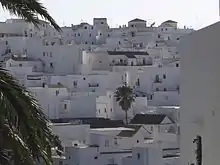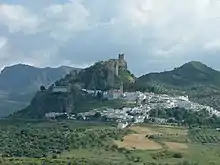White Towns of Andalusia
The White Towns of Andalusia, or Pueblos Blancos, are a series of whitewashed towns and large villages in the northern part of the provinces of Cádiz and Málaga in southern Spain, mostly within the Sierra de Grazalema Natural Park.
.JPG.webp)
History and description
The area has been settled since prehistoric times, and some of the local caves have ancient rock paintings. Iberian people, Rome, Visigoths or Arabs are some of the settlers before Modern Era that left their print. These villages show the way of life that was followed at the time of Al-Andalus, its urban planning, the economy which was linked to oil culture, the craftsmanship of leather products as well as the presence of this culture on the most of the villages' names.[1]
All of the villages are characterised by whitewashed walls and red or brown tiled roofs. They also commonly present narrow alleyways, steep earrings, lookouts, picturesque town centers with a square, church and town hall. Often local institutions manage archeological museums with Roman or Arab artifacts, as well as others dedicated to local customs, crafts or trades.
The reasons for the white color has been postulated to be a chemical result of the limestone used.
Villages and Routes
There are proposed routes to visit some of the villages. Of special interest are the ones close to Ronda (province of Málaga) and Arcos de la Frontera (province of Cadiz).
Ronda's White Towns route:
- Ronda, including the ancient Roman settlement of Acinipo archeological site.
- Setenil de las Bodegas, some parts of the village use the rocky mountains as walls and roof of the houses.
- Torre Alháquime
- Olvera
- Algodonales, 16th-century town with some Roman ruins
- Zahara de la Sierra, it is in the Sierra de Grazalema Natural Park next to a reservoir.
- Grazalema
- Benaocaz, small village with a fortress
Arcos de la Frontera's White Towns route:
- Alcalá de los Gazules
- Medina Sidonia, including the Roman settlement of Asido.
- Arcos de La Frontera, perched on a cliff, remarkable are its Baroque churches.
- Bornos and Villamartín - reservoir, Roman ruins
- Ubrique, largest of the White Towns, high quality leather crafts among other features.
- Casares
- Jimena de la Frontera
- Castellar de la Frontera
Other interesting villages and places to visit include:
- Mijas Pueblo - Burro Taxi, Old Cathedral - typical Spanish white village
- Garganta Verde and Ermita de la Garganta - caves with stalactites and stalagmites
- Puerto de las Palomas - splendid views
- Villaluenga del Rosario - highest of the White Towns and one of the prettiest
- Benamahoma - contains the Fuente de Nacimiento of Majaceite river
- El Bosque - trout fishing and hang gliding from here
- Prado del Rey - a more modern village
- Puerto Serrano - nice quiet town
- El Gastor - Balcón de los Pueblos Blancos with an interesting church
- Alcalá del Valle - pretty town - megalithic standing stones nearby
- Algar - up a mountain road
- Espera - panoramic views
- Vejer de la Frontera
- Frigiliana - musk wine and olive oil
- Bornos
- Montefrío - a top 10 National Geographic[2] views in the world
Climate
The climate is mild and the surrounding countryside is green and pleasant. Tourist activities available include hiking, rock-climbing, pot-holing, cycling, horseback riding, and just ambling about, enjoying nature and the local food.
References
- "Los pueblos blancos". Cádiz turismo. Retrieved 10 December 2020.
- "10 pueblos con las mejores vistas del mundo". viajes.nationalgeographic.com.es (in Spanish). 2015-03-20. Retrieved 2020-09-02.


.jpg.webp)

.jpg.webp)
